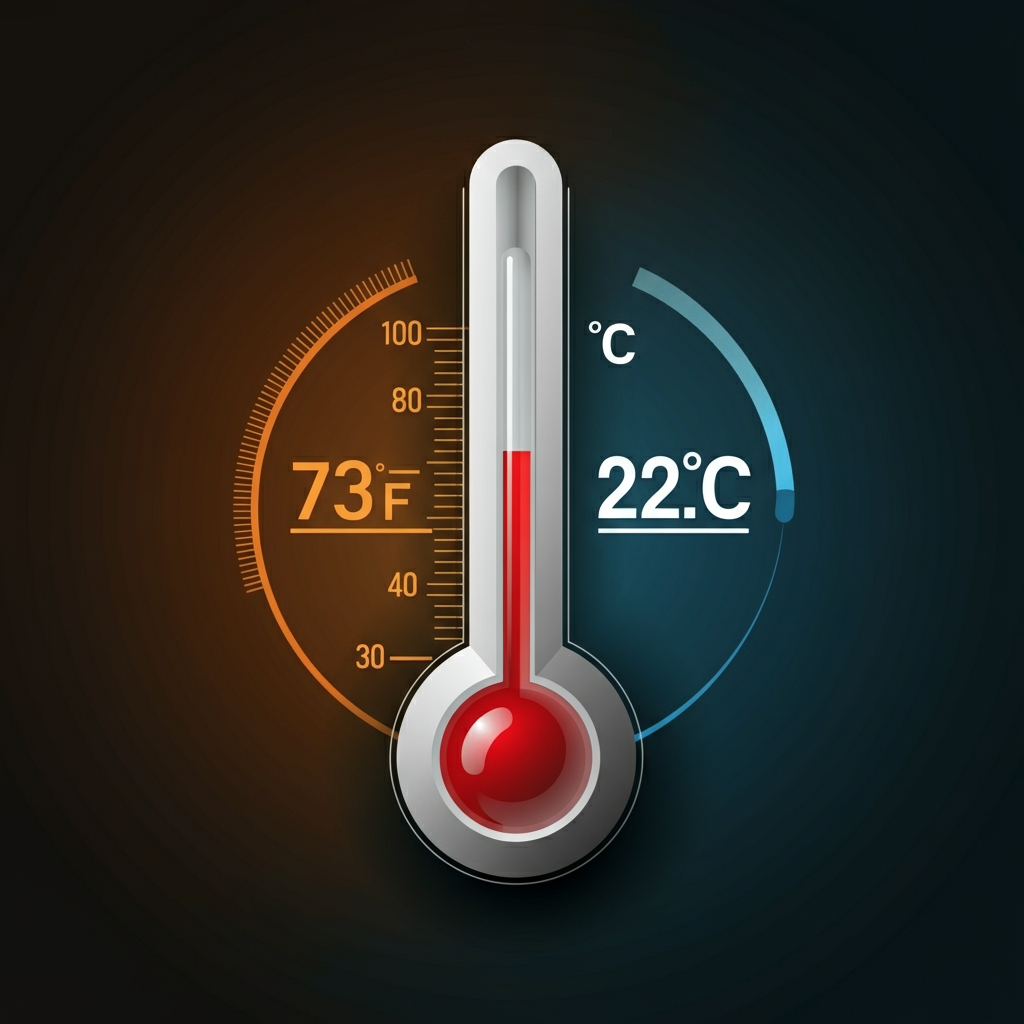Converting 73 degrees Fahrenheit to Celsius is a common temperature conversion many people need, whether you’re checking weather forecasts, cooking, or working with scientific data. The answer is simple: 73°F equals 22.78°C (or approximately 23°C when rounded).
Understanding temperature conversions becomes essential when traveling internationally, following recipes from different countries, or working in scientific fields where Celsius is the standard. This guide will show you exactly how to convert 73 Fahrenheit to Celsius and provide you with the tools to make any temperature conversion confidently.
The Simple Formula for Converting 73 Fahrenheit to Celsius
Converting 73 Fahrenheit to Celsius requires a straightforward mathematical formula:
°C = (°F – 32) × 5/9
Let’s apply this formula to convert 73°F:
- Step 1: 73 – 32 = 41
- Step 2: 41 × 5/9 = 22.78
Therefore, 73 Fahrenheit to Celsius equals 22.78°C.
Breaking Down the Conversion Process
The conversion formula works because the Fahrenheit and Celsius scales have different starting points and intervals. Fahrenheit sets water’s freezing point at 32°F and boiling point at 212°F, creating a 180-degree range. Celsius uses 0°C for freezing and 100°C for boiling, spanning exactly 100 degrees.
This means each Celsius degree equals 1.8 Fahrenheit degrees, which is why we multiply by 5/9 (the reciprocal of 1.8) in our conversion formula.
What Does 73°F (22.78°C) Feel Like?
Now that you know 73 Fahrenheit to Celsius equals approximately 23°C, you might wonder what this temperature actually feels like.
Comfort Level
At 73°F/23°C, most people find the temperature quite comfortable for indoor activities. This temperature sits within the ideal range for home heating and cooling systems, making it perfect for:
- Relaxing at home without additional heating or cooling
- Light indoor exercises like yoga or stretching
- Working from home in comfortable clothing
- Sleeping comfortably with light bedding
Seasonal Context
This temperature typically occurs during:
- Pleasant spring days in temperate climates
- Mild autumn afternoons
- Cool summer mornings before the day warms up
- Indoor temperatures in well-regulated buildings year-round
Quick Reference: Common Fahrenheit to Celsius Conversions
While we’re focusing on 73 Fahrenheit to Celsius, here are some other useful temperature conversions you might need:
Around 73°F
- 70°F = 21.11°C
- 72°F = 22.22°C
- 73°F = 22.78°C
- 74°F = 23.33°C
- 75°F = 23.89°C
Common Reference Points
- 32°F = 0°C (water freezes)
- 68°F = 20°C (typical room temperature)
- 98.6°F = 37°C (normal body temperature)
- 212°F = 100°C (water boils)
When You’ll Need This Conversion
Understanding how to convert 73 Fahrenheit to Celsius becomes useful in various real-world situations:
Travel and Weather
International weather reports use Celsius, so knowing that 73°F equals about 23°C helps you pack appropriately and understand local weather conditions.
Cooking and Baking
Many international recipes specify temperatures in Celsius. While 73°F isn’t a cooking temperature, understanding the conversion process helps with all temperature-related recipe adjustments.
Science and Education
Scientific measurements typically use Celsius, making temperature conversion skills essential for students and professionals in STEM fields.
Health and Medical Applications
Medical equipment and international health guidelines often use Celsius measurements, though 73°F/23°C falls well within normal environmental temperature ranges.
Alternative Conversion Methods
Besides the standard formula, you can convert 73 Fahrenheit to Celsius using these approaches:
Mental Math Shortcut
For quick approximations:
- Subtract 30 from the Fahrenheit temperature
- Divide by 2
For 73°F: (73-30) ÷ 2 = 21.5°C
This gives you 21.5°C, which is close to the exact answer of 22.78°C and works well for rough estimates.
Digital Tools
- Smartphone calculators with conversion functions
- Voice assistants (“Hey Siri, what’s 73 Fahrenheit in Celsius?”)
- Online conversion websites
- Weather apps that display both scales
Understanding Temperature Scales Better
The relationship between Fahrenheit and Celsius becomes clearer when you understand their origins and applications.
Fahrenheit Scale
Daniel Gabriel Fahrenheit created this scale in 1724, originally basing it on the freezing point of a salt-water solution. The United States, Bahamas, Belize, and Cayman Islands primarily use Fahrenheit for everyday temperature measurements.
Celsius Scale
Anders Celsius developed this scale in 1742, initially setting 100° as water’s freezing point and 0° as its boiling point. The scale was later inverted to its current form. Most of the world uses Celsius for weather, cooking, and scientific applications.
Practical Tips for Temperature Conversion
Remember Key Benchmarks
Memorizing a few key conversions helps you quickly estimate others:
- 0°C = 32°F (freezing)
- 20°C = 68°F (room temperature)
- 30°C = 86°F (warm day)
Use the Conversion Formula Regularly
Practice converting temperatures you encounter daily. The more you use the formula for 73 Fahrenheit to Celsius and similar conversions, the more natural it becomes.
Check Your Work
When possible, verify conversions using multiple methods or online calculators to ensure accuracy, especially for important applications.
Master Temperature Conversions with Confidence
Converting 73 Fahrenheit to Celsius demonstrates a fundamental skill that serves you well in our globally connected world. Whether you’re traveling internationally, following international recipes, or pursuing scientific studies, understanding that 73°F equals 22.78°C gives you practical knowledge you’ll use repeatedly.
Practice the conversion formula with different temperatures, memorize key reference points, and consider downloading a reliable conversion app for those moments when quick accuracy matters most. With these tools, you’ll handle any temperature conversion confidently and accurately.









![Project XL Trello Link & Wiki [Verified & Official] [January 2025]](https://reelsmedia.co.uk/wp-content/uploads/2025/01/Roblox-Project-XL-Trello-Link-Wiki-Verified-Official-330x220.jpg)







